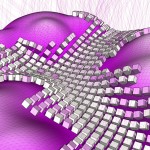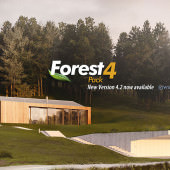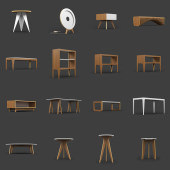SketchUP V-Ray Proxy Grass
Creating 3D Grass and Scattering it all over the place inside 3dsmax was featured here plenty, but with V-Ray for SketchUP becoming better and better it can be done inside SU too with great results and little effort as David Brufau showcases in this short how-to. Follow his process and feel free to jump in with questions or suggest your own methods of doing this inside SketchUP.
Author: David Brufau
David Brufau in an Architect and Architectural Visualization Artist based in Barcelona, Spain. He started his own practice, specialized in ArchVIZ back in 2010 and he uses SketchUP as his main tool for that… along with V-Ray for SketchUP as his render engine of choice.
Modeling the single Grass Blade
You could easily start with a ready made mesh and texture like the one that was provided a few days ago here – Free Grass by Mischa Winkler, but my aim was to do it all solo inside SketchUP so you can see how simple it is.
It similar to how Peter Guthrie is doing this inside 3dsmax as featured on his blog – V-Ray Grass Tutorial Part 1 and V-Ray Grass Tutorial Part 2.
To start, we can easily push-pull two shapes into one another. The resulting intersection will be the base for our grass-blade.
This is the resulted shape. The segments here are the result of the initial curve detail drawn up above.
With a quick scale we can make this blade as thin as needed.
Creating the Grass Blade Texture
You can easily find a ready-made blade texture, but the point of this exercise was to do this solo. To start, I create a new blank canvas in Photoshop.
After a quick search in Google Images, I find a good color base to work with for the grass blade texture.
I paste it onto the empty canvas inside Photoshop and blur it out since I only need the general colors.
Adding the dark / light gradient form the bottom of the blade texture.
Doing the same with the middle fold of the blade from inside outwards.
Apply some falloff to this fold so it is less strong up above.
Adding the blade detail with a simple black and white streaks mask.
And there you have it!
Applying the Texture
Next thing is to apply that texture onto the blade model. I’m placing the texture so it fits one face and then I just capture the texture and paint it over the rest so it all flows smooth.
This is how the blade looks like without the fold modeled yet.
Adding an additional line along the center will allow…
A scale operation to be made and get the fold locked in the model itself too.
Scattering and Export to VRMesh
For the scattering I’m using the Make Fur plugin by Tak2hata which can generate grass, or any other object for that matter, using a variety of parameters to distribute them randomly over an area.
See this video for an overview of what can be done with it and follow my process right after.
Here is my small patch of scattered blades using the Make Fur plugin.
Next thing is to convert it into a V-Ray Proxy object. Clicking on the toolbar export button and picking a folder to save into.
Replace the full version with the proxy version, and also control the amount of triangles if you like. This is not critical as we are going to simply this even further.
Replacing V-Ray Proxy with Simple Geometry
I’m taking a very simple approach to using proxy stand-ins inside SketchUP. We don’t even need the small triangle amounts generated by the proxy export process… All we need is the patch boundary – This could be a simple line circle. Considering the amount of proxies we are going to scatter, this will help a lot to reduce the load on the viewport.
I’m picking the triangles and hiding them away, as well as the base circle face – all we need is the circle.
Or any other shape that defines the patch you created. In this case I made two. I also add a small line point upwards to indicates that so we don’t flip them by mistake during a scatter operation.
Quick Test and making the Lawn
I’m doing a quick test render to make sure the proxies are working ok first.
Next, to demonstrate with a lawn, I’m creating the plane on which we will scatter the proxies.
I’m using the Make Fur plugin again, this time with the Crowd scatter feature which allows loading of several SketchUP components for the process.
This is how it all looks after the scatter :
Zoomed in…
And test rendered too…
This is how it looks in the end!
Not too complex and all done from within SketchUP!
In the following how-to you’ll see how I made a more complex scene based on the same method showcased here.














































Hasrul Zaimy Man Brick
I need that about max
Check the related posts section below these comments – You’ll find plenty about MAX 😉
Here’s a screen shot of the above bridge SketchUP model…
Long Hip này
i don’t use sketchup, but this is a nice tutorial… i have a question: why do you use vray proxy with a small grass clump? i believe this is totally unnecessary… thanks
aptoverde Why do you think so?
Check inside the article at the end – “Related Posts” section for this
Thanks you so much for this tutorial, i’m gonna try this as soon as possible 😀
I need processing power, cause I can just do flat grass or photoshop fake it.
Great tutorial! I have only one problem with, I cant seem to get the proxy to keep the texture map when I load it again in to the model.
(y)
Santiago RIzo Z I am having this same issue with all my proxies. I’ve tried so many solutions and nothing has worked. Someone help!
ngchristianson Santiago RIzo Z If I remember correctly, proxies dont maintain material information. they load generic colours as placeholders to be replaced. The alternative is to set up the proxy in its own file with the proper materials in play, then save that sketchup file. And to use later simply import through sketchup as normal
now i guess i’ll never have to switch to max 😉
aptoverde Then you do not understand how proxies work.
If you were to scatter thousands of individual clumps of grass, each one would have to be individually loaded into RAM, creating a huge amount of unecessary RAM usage.
With a proxy, the clump is only loaded into RAM once, then referenced/called up whenever a ray hits it.
Excellent tutorial. I’d love to see a similar description of the the river and bridge tutorial.
sir, in bridge SKETCHUP model, which plugin u used to make the land undulated.
it would be helpful as i am new to sketchup.
So useful tutorial, thanks you very much!
Hello, Very great tutorial, but i don’t understand why my proxies are so big when I use the “Make Fur” tool on a big field ? My Sketchup have some difficulties to create many proxies. Thank you very much 🙂
great tutorial.! thanks! but i dont get it why it throw me out the program when i render it with HDRI dome light?
How do you render the hidden geometry? Everything else works fine, but when i try to hide the geometry, Vray wont render it, no matter what. Is that an option, or a plugin?
GieltonLuiz same problem here!!!
GieltonLuiz Yes, this is the only thing in the tutorial that has me stumped as well. Any know the answer?
C_L_Smith GieltonLuiz
I found out later that if you create the proxy, and then after its been created you click in the groups until you can select its geometry (the little triangles), you can hide those, they will still render.
GieltonLuiz C_L_Smith Great, thanks!
GieltonLuiz how can i do like that picture? my texture is to bad and unreal,please answer
QuentinRajnelli can u help?
i cant understand the scattering part 🙁
MarkMora1 We are solving the Scattering problem in SketchUp with Skatter 😉 See here Getskatter.com
V1 release is coming soon #GetSkatter #SketchUp
Awesome Tutorial, very Helpfull.
With some Material setting I got this result 😀
https://drive.google.com/file/d/0B8IQ6ap76VaeQ0JVOEJKY0pIMDg/view?usp=sharing